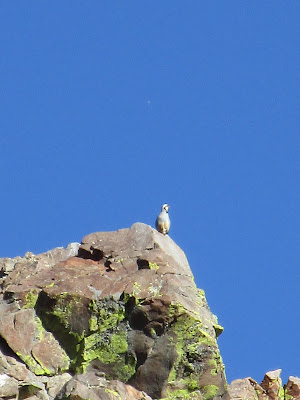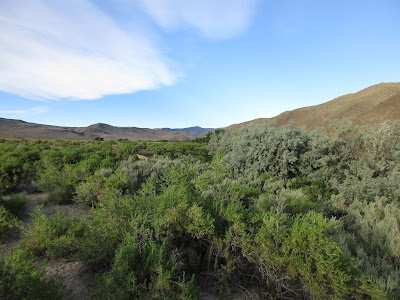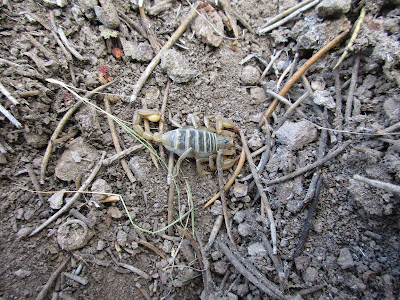My sixth tour on the NBC started earlier than normal, on the weekend after our fifth tour, because there were a few extra transects that needed to be done and the boss was looking for people who wanted to do them. On weekends like last one where I have no means of getting away from the field house (I really need to get a car!) I'm always chomping at the bit to get away and do something, so getting to work in the mountains for pay seemed like a great idea.
Making it even more enticing, the transect needing to be done was one part of a brand new NBC contract in the Virginias and nearby ranges up north of Reno. Most of our sites are part of long-running projects, and the NBC veterans like Dave and Sue have surveyed most of them over the years. The Virginias, however, were new to this season, so not even they knew what to expect. Luckily my whole first half of the tour was stationed up there to knock out the majority of the transects, so it was a rare opportunity on the NBC to explore the unknown area.
So I headed up on my own on Friday June 17th to spend the night in the oddly named Dogskin Range to be in position for a survey the next morning. In this range and in the nearby ranges the usual PJ of Nevada's mid-elevation ranges was reduced to simply J, as the forests were entirely scattered junipers. Apparently the pinyons drop out very quickly once you get north of Reno. Lots of rock outcrops scattered around added to the scenery.
Much of Nevada is used as open rangeland for cattle, so it's not unusual to come across a few while driving or hiking throughout the state.
That night after getting to camp I wandered around a while to see what was about. A Mountain Quail crowing from a distant hillside was a nice find, although not quite as nice as the Northern Pygmy-Owl I was trying to turn the distant call into, and a soaring Golden Eagle was a treat as always. Although my favorite sighting was around dusk when four Long-eared Owls flew right into the trees around camp. I've been having incredible luck with these owls this season! The local Blue-gray Gnatcatchers didn't like the owls as much as I did, resulting in this humorous video. It's not terribly sharp due to the lack of zoom on my camera, but it captures the essence of the encounter.
On my survey the next morning the birds were similar to the PJ birds in the Pine Nuts although lacking some of the species preferring thicker forest, with Juniper Titmice and Bushtits being a couple highlights. However it was the scenery that morning that really captured my interest. While the skies were clear at dawn, the wind quickly picked up from the West and pushed patches of dark menacing clouds rapidly by overhead. These clouds were low enough to shroud the tops of the surrounding ridges.
Another cool find was this neat formation I saw in one of the rock faces. I showed the photos to Sue, who has a fair bit of geological knowledge, and it turns out this formation is called a concretion. They originate in the formation of sedimentary rock, when minerals precipitate in layers around some sort of nucleus within the sediment, such as a pebble or shell. Apparently you can crack open some concretions an find a perfect fossil in its centre.
 |
| Concretion |
Also that morning I came across one of my favorite wildflowers out here, Cobweb Thistle (Cersium occidentale). It may sound funny to be fond of a thistle, but I find these flowers with their ghostly white stems contrasting bright pink inflorescences very beautiful.
 |
| Cobweb Thistle |
After the morning of surveying I was back to the field house until the end of the weekend when Kayla and I headed back up to the Virginias for another three mornings of surveys. We drove in late in the evening on Monday the 20th and were treated to some spectacular clouds lit up by the setting sun.
A pronghorn doe enjoyed the sunset as well.
An even more incredible encounter happened on my final count of the morning. Not too much was going on, and I enjoyed the quiet count by watching a male Horned Lark giving its display flight. It would climb upward with 4 bursts of wingbeats, and on the fifth it would let out it's lovely tinkling song. Then it would climb another 5 steps and repeat, until it was a speck overhead. While watching the bird I heard the unusual sound of a male pronghorn's alarm call and saw two young bucks and an older male come over the nearby ridge. They were followed by a curious youngster who, not used to seeing strange two-legged beings, decided to investigate. I stood motionless as the fawn came slowly closer and closer to me, while the concerned mature buck followed some distance behind. The fawn eventually stopped a mere 15m from me, and for a moment paused to decide what it thought of this intruder. It then decided it wasn't worth getting any closer, and took off in a circle around me. The buck, at this point some 50m away, then took off at a run and followed a wider circle around me after its kid. Seeing a full grown male pronghorn take off and get up to speed from so close is a truely impressive thing. These animals are built on muscles made for running, and have been built that way since the ice age when they needed them to outrun the American Cheetah. No video of this encounter unfortunately, but I decided to keep the camera on my belt this time and just absorb the experience while it was happening.
That afternoon, with temperatures climbing to the mid-high 30s Celsius, we decided to head over to nearby Pyramid Lake to look for a shady place to putt on paperwork for the afternoon. Pyramid Lake is one of the few large terminal lakes in this desert state, and belongs to the Pyramid Lake Indian Reservation. We had to pay a $10 day use fee for our stay, but our nice set up under a shaded awning, with a picnic table to work on and a scope set up to watch the grebes and pelicans, it was worth it.
That afternoon, with temperatures climbing to the mid-high 30s Celsius, we decided to head over to nearby Pyramid Lake to look for a shady place to putt on paperwork for the afternoon. Pyramid Lake is one of the few large terminal lakes in this desert state, and belongs to the Pyramid Lake Indian Reservation. We had to pay a $10 day use fee for our stay, but our nice set up under a shaded awning, with a picnic table to work on and a scope set up to watch the grebes and pelicans, it was worth it.
 |
| Paperwork and pelicans at Pyramid Lake |
The following morning I had a hilly transect just northwest of the lake. Birds were downright quiet here, but the views of the lake and surrounding hills were spectacular. At the north end of the lake are large tufa sandstone formations called The Needles, and I was lucky enough to get to watch the sun rise behind them.
Atop my highest ridge while looking over the cliff in the valley below I got a rare look at a Golden Eagle from above. It was really something to watch it gliding over the valley below me, with its shadow gliding over the sagebrush and cheatgrass below it on the valley floor.
The rocky terrain on these ridges was perfect for lizards, and I saw numerous Great Basin Collared Lizards along with the more widespread Western Fence Lizards.
The afternoon and evening was spent driving all over the wilderness trying to find an alternate way into our transects for the next day, since our original route was thwarted by a gate on private land. Eventually we found a long, rough road in too late to attempt, so we took Plan B and got into camp by some back-up transects just before nightfall. Happy to finally be off the road, we took a break for a little astronomy. With the naked eye we were able to pick out 3 different planets, and after getting out my scope we had amazing views of Mars, the bands on Jupiter plus all 4 of its large moons (Io, Europa, Ganymede, and Callisto), and the brilliant rings on Saturn in addition to its large moon Titan. A great way to end a long day.
Our final morning in the Virginias was fairly low-key, with my transect passing through rocky, hilly scattered juniper country again.
 |
| Sunrise over The Needles |
Atop my highest ridge while looking over the cliff in the valley below I got a rare look at a Golden Eagle from above. It was really something to watch it gliding over the valley below me, with its shadow gliding over the sagebrush and cheatgrass below it on the valley floor.
The rocky terrain on these ridges was perfect for lizards, and I saw numerous Great Basin Collared Lizards along with the more widespread Western Fence Lizards.
 |
| Great Basin Collared Lizard |
 |
| Western Fence Lizard |
The afternoon and evening was spent driving all over the wilderness trying to find an alternate way into our transects for the next day, since our original route was thwarted by a gate on private land. Eventually we found a long, rough road in too late to attempt, so we took Plan B and got into camp by some back-up transects just before nightfall. Happy to finally be off the road, we took a break for a little astronomy. With the naked eye we were able to pick out 3 different planets, and after getting out my scope we had amazing views of Mars, the bands on Jupiter plus all 4 of its large moons (Io, Europa, Ganymede, and Callisto), and the brilliant rings on Saturn in addition to its large moon Titan. A great way to end a long day.
Our final morning in the Virginias was fairly low-key, with my transect passing through rocky, hilly scattered juniper country again.
The rocky terrain seemed great for snakes, so I was keeping my eyes out. One thing that kept me on my toes were the dried lupine stalks. When kicked, their dry seed pods would rattle together and make a sound surprisingly similar to that of a rattlesnake. Whether or not you want to find them or not, hearing that rattle always makes your heart stop briefly! Didn't luck into any Great Basin Rattlesnakes this time, but this young Great Basin Gophersnake on my way back was a nice consolation prize.
 |
| Great Basin Gophersnake |
Also on the way back I got close views of a pair of Swainson's Hawks mobbing a Golden Eagle which was fun to see. Additionally, fairly close to me meeting point I flushed another 3 Long-eared Owls! There must be a good population of rodents this year because I keep tripping over these birds.
And with that we finished the first half of our tour. After our mid-tour area search we were excited to have a circuit of transects in 3 different mountain ranges to round our the second half of the tour: the Sierras, the Pine Nuts, and finally back up to the Virginias.













































